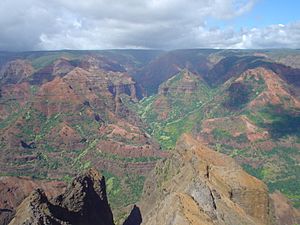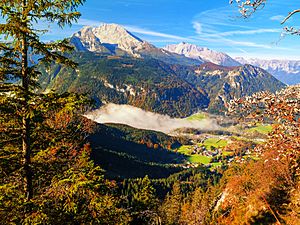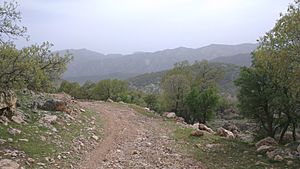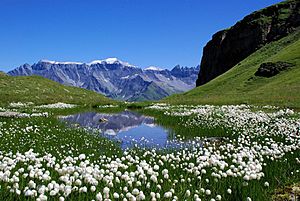Montane ecosystems facts for kids
Montane ecosystems are special places found on the slopes of mountains. Imagine climbing a mountain: as you go higher, it gets colder and windier. This change in climate strongly affects the plants and animals that live there. Because of this, mountains often have different "layers" or zones of life, with different kinds of forests or grasslands at different heights.
At middle elevations, where temperatures are mild and there's lots of rain, you'll often find thick forests. But if you go even higher, the weather gets much tougher. It's too cold and windy for tall trees to grow, so the plants change to tough grasses, small shrubs, or even just moss and lichen.
Because mountain climates are so unique, many plants and animals found there live nowhere else in the world! These special places also help us by storing carbon and providing fresh water.
Contents
Life zones on Mountains
As you climb a mountain, the air gets cooler. This happens because the air pressure drops, and the air itself cools down. Think of it like this: going up 100 meters on a mountain is similar to traveling 80 kilometers (about 50 miles) closer to the North or South Pole!
Because the climate changes so much with height, different types of plants and animals live at different elevations. This creates what we call "life zones"—bands of similar ecosystems found at similar heights on a mountain.
One common life zone is the montane forest. These dense forests grow at middle elevations where there's enough rain and the temperatures are just right.
Above the montane forest is the subalpine zone. Here, the trees start to get thinner and become twisted and stunted. This happens because the winds are much stronger at higher elevations. Eventually, you reach the tree line, which is the highest point where trees can still grow.
Even higher than the tree line is the alpine zone, also known as alpine tundra. In this zone, it's too cold and windy for trees. Instead, you'll find tough grasses, small shrubs, cushion plants, mosses, and lichens. These plants have special ways to survive the cold, dry, and windy conditions, like growing close to the ground or having hairy leaves.
If you go even higher, above the alpine zone, it gets so cold that you'll mostly find just rock and ice.
Montane Forests
Montane forests are found between the lower mountain areas and the higher subalpine zones. The exact height where these forests begin and end can be different depending on where you are in the world, especially how close you are to the equator. The top edge of a montane forest, the tree line, often changes to tougher tree types that grow further apart. For example, in California's Sierra Nevada mountains, the montane forest has thick groups of lodgepole pine, but higher up, the subalpine zone has fewer whitebark pine trees.
Sometimes, the lower edge of a montane forest is a "lower timberline" that separates it from drier areas like steppes or deserts.
Montane forests are different from forests in flat, low-lying areas nearby. Because it's colder in the mountains, montane forests often have tree species that you'd normally find in colder regions further north or south. People can also change montane forests through logging or farming. On mountains that are far away from other mountains, montane forests surrounded by dry, treeless areas are like "sky islands"—unique ecosystems isolated from others.
Temperate Montane Forests
Montane forests in areas with a temperate climate are usually either conifer forests (like pine or fir trees) or mixed forests (with both conifer and broadleaf trees). These types of forests are common in places like Europe and North America. However, the exact trees might be different from those found in colder, flat areas because of the mountain's unique geology and climate.
Montane forests outside of Europe often have more types of species. This is partly because Europe's main mountain ranges run east to west, which can limit how species spread.
You can find temperate montane forests in many places, including the Alps in Europe, the Cascade Range in North America, parts of South America, New Zealand, and the Himalayas.
Scientists think that climate change will affect these forests. For example, in the Pacific Northwest of North America, less snow and more summer droughts could harm montane wetlands.
Mediterranean Montane Forests
Montane forests in Mediterranean climates are warm and dry most of the year, but they get more rain and milder temperatures in winter. These forests are known for having very tall trees and lots of plant life. They are usually a mix of conifer and broadleaf trees, but with only a few types of conifers. Pine and juniper trees are common here. The broadleaf trees are more varied and are often evergreen, like evergreen oaks.
You can find this type of forest around the Mediterranean Sea, in North Africa, Mexico, the southwestern United States, Iran, Pakistan, and Afghanistan.
Tropical Montane Forests
In tropical regions, montane forests can be made up of broadleaf trees or conifer trees. A special type of tropical montane forest is a cloud forest. These forests get most of their moisture from clouds and fog that hang around the mountains. Cloud forests often have lots of moss covering the ground and trees, which is why they are sometimes called mossy forests. These mossy forests usually grow in mountain saddles, where moisture from the clouds stays trapped.
Tropical montane forests are very sensitive to climate change. Changes in temperature, rain, and humidity can stress these forests. Scientists predict that climate change could lead to a loss of different plant and animal species and change how communities of plants and animals interact. Some global climate models also predict less cloudiness in the future, which might already be affecting places like the Monteverde cloud forest in Costa Rica.
Subalpine Zone
The subalpine zone is the area just below the tree line on mountains around the world. The exact height of the tree line changes a lot depending on where you are. In tropical Southeast Asia, it might be above 4,000 meters (13,000 feet), but in Scotland, it can be as low as 450 meters (1,500 feet). The types of trees you find in this zone also depend on the location. For example, you might see scrub mountain pine in Europe or subalpine fir in North America.
Trees in the subalpine zone often become krummholz, which means "crooked wood." These trees are stunted and twisted in shape. At the tree line, young trees might start growing on the side of a rock that's protected from the wind. They only grow as tall as the rock provides shelter. Any growth above the rock or snow cover is usually destroyed by the harsh winds. Krummholz trees can be very old, sometimes hundreds or even a thousand years old!
You can also find meadows in the subalpine zone. Tuolumne Meadows in California's Sierra Nevada is a good example of a subalpine meadow.
Examples of subalpine zones around the world include the French Prealps in Europe, the Sierra Nevada and Rocky Mountains in North America, and parts of the Himalayas in Asia.
Alpine Grasslands and Tundra
Alpine grasslands and tundra are found above the tree line, in a world of strong sunlight, wind, cold, snow, and ice. Because of these tough conditions, alpine plants grow very close to the ground. They are mostly perennial grasses (plants that live for more than two years), sedges, and other small flowering plants. Annual plants (plants that live for only one year) are rare here and usually only a few inches tall.
Alpine plants have amazing ways to survive. Cushion plants look like clumps of moss hugging the ground. This helps them escape the strong winds blowing just a few inches above them. Many flowering plants in the alpine tundra have thick hairs on their stems and leaves to protect them from the wind. Some even have red colors that help them turn sunlight into heat. Some plants take two or more years to form flower buds, which stay safe under the snow all winter and then open quickly to produce seeds during the short summer. Non-flowering lichens stick to rocks and soil. Their tiny cells can make food from sunlight even when it's just above freezing, and their outer layers can soak up a lot of water.
Even though tundra plants seem very tough, they are actually quite fragile. If people walk on them repeatedly, the plants can be destroyed, leaving the soil exposed to blow away. It can take hundreds of years for the tundra to recover.
Alpine meadows form where weathered rocks have created good soil for grasses and sedges. Alpine grasslands are so common worldwide that the World Wildlife Fund calls them a "biome" (a large natural area with similar plants and animals). This biome, called "Montane grasslands and shrublands," often developed like islands, separated from other mountain regions by warmer, lower areas. Because of this, they often have many unique plants that evolved specifically for the cool, wet climate and bright sunlight.
The largest montane grasslands and shrublands are found in the Andes Mountains in South America, called páramo. This biome also exists in the mountains of East and Central Africa, Mount Kinabalu in Borneo, the highest parts of the Western Ghats in South India, and the Central Highlands of New Guinea. A unique feature of many wet tropical mountain regions is the presence of giant rosette plants, which are large, cabbage-like plants from different plant families.
In drier mountain areas, you might find montane grasslands, savannas, and woodlands, like in the Ethiopian Highlands, or montane steppes, like on the Tibetan Plateau.
See also
 In Spanish: Montano para niños
In Spanish: Montano para niños
- Forest ecology
- Tree line
- Temperate coniferous forests
- Ecology of the Rocky Mountains
- Sierra Nevada lower montane forest
- East African montane forests
- Afromontane, a series of high-elevation regions in Africa
- California montane chaparral and woodlands, an ecoregion.
- Angolan montane forest-grassland mosaic, an ecoregion.
- Australian Alps montane grasslands, an ecoregion.
- South Western Ghats montane rain forests, an ecoregion
- Polonyna (montane meadow)
- Altitudinal zonation
- Biome









